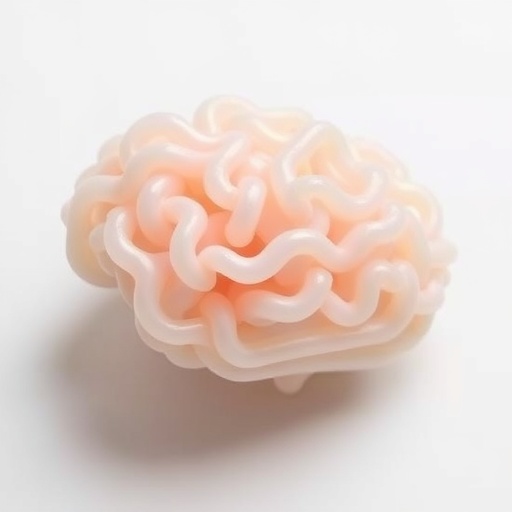In a groundbreaking study, researchers led by Professor Byoung Soo Kim at Pusan National University have developed a revolutionary 3D-bioprinted model of stenotic brain vessels, mimicking conditions associated with cerebrovascular diseases such as atherosclerosis and stroke. These conditions are often characterized by vascular stenosis, a narrowing of blood vessels that disrupts normal blood flow and leads to chronic inflammation within the vessel walls. The endothelial cells that line these blood vessels respond to the shear stress and disturbed hemodynamics caused by this narrowing by expressing various pro-inflammatory molecules. However, studying this process in living systems has long been a challenge due to their inherent complexity and variability.
Traditional experimental models, such as static cell cultures and basic microfluidic systems, often fail to adequately replicate the intricate structural and biological complexities of the human cerebrovascular environment. This has intensified the demand for more physiologically accurate models that can effectively reflect how abnormal flow patterns contribute to endothelial dysfunction and inflammation, which are critical components of cerebrovascular diseases.
To tackle this significant research gap, Professor Kim and his collaborators, including Researcher Min-Ju Choi from Pusan National University and Professors Dong-Woo Cho and Dr. Wonbin Park from Pohang University of Science and Technology (POSTECH), utilized a novel embedded coaxial bioprinting technique. This technique enabled them to fabricate perfusable vascular conduits with precise control over luminal narrowing, thus allowing for the simulation of stenotic brain vessels in a laboratory setting. Their findings were published online in the esteemed journal Advanced Functional Materials, highlighting a significant advancement in the field of biomedical engineering.
.adsslot_03b9ojdpMJ{ width:728px !important; height:90px !important; }
@media (max-width:1199px) { .adsslot_03b9ojdpMJ{ width:468px !important; height:60px !important; } }
@media (max-width:767px) { .adsslot_03b9ojdpMJ{ width:320px !important; height:50px !important; } }
ADVERTISEMENT
The research team created a bioink that was a hybrid of porcine aorta-derived decellularized extracellular matrix, collagen, and alginate. This unique composition not only provided the necessary mechanical strength but also introduced vital biological cues that support endothelial cell adhesion and functionality. The bioprinted vessels incorporated human endothelial cells, specifically umbilical vein endothelial cells and brain microvascular endothelial cells, enabling them to emulate the flow conditions found in both normal and stenotic blood vessels.
One of the standout features of this innovative bioprinting model is its ability to maintain endothelial barrier integrity. Under disturbed flow conditions typical of stenotic blood vessels, there was a notable upregulation of specific inflammatory markers, indicating a mature endothelial barrier’s physiological responses. This capability could provide critical insights into the mechanisms of endothelial inflammation and vascular pathology associated with cerebrovascular diseases.
Professor Kim’s research marks a pivotal advancement in cerebrovascular disease modeling, as it allows for the creation of anatomically and physiologically relevant blood vessels. By employing a robust extracellular matrix-based bioink in conjunction with coaxial bioprinting technology, this innovative model replicates the critical geometrical and flow dynamics characteristic of stenotic vessels. The versatility of this platform significantly broadens its applications in disease modeling and personalized medicine approaches, ultimately working to transform the landscape of treatment options for cerebrovascular diseases.
Furthermore, the researchers foresee future enhancements to the model, including the integration of brain-specific extracellular matrix components, co-culturing strategies involving vascular support cells, and using patient-derived cells to enhance physiological accuracy and create personalized models for disease studies. The potential integration of organ-on-a-chip systems and AI-driven analytics will further enable real-time monitoring of endothelial responses to various therapeutic interventions, paving the way for more effective and personalized treatment strategies.
The implications of this research extend well beyond academic curiosity; the potential to significantly reduce reliance on animal testing while improving drug screening and toxicity assessments is a monumental advancement in biomedical research. As the field of bioprinting continues to advance, these technologies could radically shift our understanding of cerebrovascular diseases, facilitating therapeutic discovery and enhancing the development of tailored treatments for patients suffering from conditions like stroke and atherosclerosis.
In conclusion, the innovative work by Professor Kim’s research group not only presents a robust and versatile platform for cerebrovascular tissue engineering but also emphasizes the promise of bioprinting technology as a transformative force in the field of medical research. As we continue to harness these advanced techniques, we pave the way for unprecedented breakthroughs in understanding and treating complex diseases, thereby improving outcomes for countless individuals at risk of cerebrovascular disorders.
Subject of Research: Lab-produced tissue samples
Article Title: Embedded 3D-Coaxial Bioprinting of Stenotic Brain Vessels with a Mechanically Enhanced Extracellular Matrix Bioink for Investigating Hemodynamic Force-Induced Endothelial Responses
News Publication Date: 24-Jun-2025
Web References: N/A
References: N/A
Image Credits: Professor Byoung Soo Kim from Pusan National University, Korea
Keywords
Tags: 3D-bioprinted brain vesselsatherosclerosis research advancementscerebrovascular disease modelingcerebrovascular health studieschronic inflammation in blood vesselscomplex biological modelingendothelial cell response to shear stressinnovative medical research techniquesmicrofluidic systems limitationsphysiological accuracy in researchPusan National University breakthroughsvascular stenosis and inflammation





